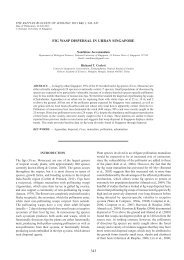1O257LF
1O257LF
1O257LF
You also want an ePaper? Increase the reach of your titles
YUMPU automatically turns print PDFs into web optimized ePapers that Google loves.
© 2010 Dinosauria International Ten Sleep Report Series No. 1<br />
tooth crowns, these studies, have speculated that branch<br />
stripping may have been employed. Stripping would require<br />
the swallowing of virtually complete vegetation without<br />
being processed into a lump through mastication. Then<br />
this vegetation must be pushed by muscle contractions in<br />
a twenty to thirty foot long neck. This strip and swallowing<br />
process seems highly improbable, unless the plant material<br />
is small fern sized foliage. Effective oral processing of plant<br />
material requires that the food be chewed into a lump for<br />
throat muscle to push against, thereby making swallowing<br />
possible. It is clear that Morrison diplodocids were incapable<br />
of chewing plant material with their front teeth. Therefore, it<br />
is believed that the reduced dentition was part of a feeding<br />
system, which incorporated a type of rostral bill.<br />
A<br />
The Rostral Bill<br />
The presence of a rostral bill is supported by the<br />
following suite of characters: rostral crest, nasal repositioning,<br />
the premaxillae and maxillae transversely extended and<br />
flattened, loss of teeth, presence of distinct grooves, channels,<br />
pits and foramina on the surface bone of the upper and lower<br />
jaws. The rostral crest is a bilaminar structure created by the<br />
median ridges of the caudal extensions of the premaxillaries.<br />
The prominence of this crest originates behind the anterior<br />
maxillary foramen and extends posteriorly terminating just<br />
before the narial opening. The crest is distinctly sculpted<br />
and flanked on both sides by shallow grooves. Its dorsal<br />
surface is somewhat flat, and tapers anteriorly. The best<br />
example of this crest is preserved in the skull CM 11161 (Fig<br />
26 C), and a reconstruction of this apomorphy is illustrated<br />
in Fig 4. A similar structure is present in the mud probing<br />
Boat-bill Heron (Cochlearius cochlearius), a nocturnal wading<br />
species. In the Boat-bill Heron, its bony crest is designed to<br />
structurally reinforce the overlying ramphotheca bill while<br />
facilitating its digging and scooping use. The development<br />
of an interfenestra bridge dividing the preantorbital from<br />
the antorbital fenestrae not only strengthens that skull area<br />
(Witmer 1997) but also to extend the continuous flattened<br />
surface area of the premaxillae and maxillae that helps to<br />
forms a duck billed shaped rostrum.<br />
This rostral bill in Amphicoelias may have been<br />
formed by durable keratinous ramphotheca or by reinforced<br />
or thickened epidermal tissue, which may have possessed<br />
a degree of leather-like flexibility. This rostral bill probably<br />
covered the snout in areas of the premaxilla, maxilla and<br />
dentary. Additionally, it is possible that a cutting edge or<br />
notch existed on the long post dental diastema, which, as<br />
indicated on the skull, may have been created by the angle<br />
of the ventral border along the maxilla and quadrajugal<br />
contact, and from the dorsal ridge of the dentary. The<br />
Fig 28 A-C, A-B. Comparison of mid cervical ribs in Amphicoelias<br />
“brontodiplodocus” belonging DQ-TY and DQ-PE from Dana<br />
Quarry. Note the proportionately more robust rib and massive, well<br />
developed, laterally extending parapophyses in DQ-PE (posterior<br />
end of rib is not shown) compared with the elongated overlapping<br />
ribs in DQ-TY. C. cervicals belonging to DQ-SB, an adult specimen<br />
displaying a shortened length compared with DQ-TY.<br />
B<br />
C<br />
38



